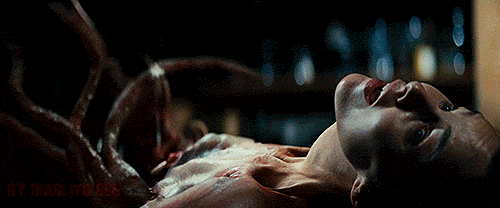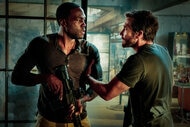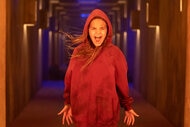Create a free profile to get unlimited access to exclusive videos, sweepstakes, and more!
The Thing's 2011 stealth-prequel actually makes both it and John Carpenter's original stronger

When director Matthijs van Heijningen Jr.’s version of The Thing was released in 2011, most viewers probably went in assuming that the movie was a straightforward remake of John Carpenter's 1982 film, itself another adaptation of John W. Campbell Jr.’s 1938 novella Who Goes There? (Blumhouse recently announced another adaptation of the sci-fi classic.) But anyone familiar with Carpenter’s original would immediately spot the foreshadowing and setup of later events, starting with the “remake’s” opening title card that indicates that its events occur at the exact same place and time (“Antarctica, Winter 1982”) as Carpenter’s film. The 2011 Thing was a secret prequel, a divisive twist that actually makes both movies stronger.
The newer Thing doesn’t play up the 1980s setting with kitschy pop-culture references or outdated technology like too many retro horror movies tend to do. There’s a cheeky joke in the scene introducing the main character, Kate Lloyd (Mary Elizabeth Winstead) as she works in her lab while listening to Men at Work’s “Who Can It Be Now?” on her headphones. But that’s really the only time that the movie mines the setting for laughs, and the nods to Carpenter’s film are all played straight, most of them not even noticeable to casual viewers.
The location at a Norwegian scientific research base forms an obvious connection to the previous film, but the reveal of a box of grenades, or the placement of an axe in the wall, or the size and shape of the block of ice containing the unearthed alien creature don’t immediately register as placeholders for later developments. Van Heijningen and screenwriter Eric Heisserer incorporate these elements organically within a framework that reinterprets the plot of Carpenter’s film (and of its predecessor, 1951’s The Thing From Another World), and this Thing is an engrossing, suspenseful horror movie that stands alone without those distractions.
As in Carpenter’s film, a mysterious prehistoric monster terrorizes the inhabitants of the remote outpost with its ability to mimic any life form it comes in contact with, and the characters begin to mistrust each other once they realize that any one of them could be the monster in disguise (who can it be now, indeed). Here, the filmmakers add an extra dimension to the character dynamics by placing Kate at the center of the story, surrounded almost exclusively by men. As a paleontologist, she’s recruited by Danish scientist Sandor Halvorson (Ulrich Thomsen) to help with excavating and studying the creature, but it’s easy to see that Sandor doesn’t much respect her, and his reckless behavior in pursuit of scientific glory is part of what leads to the creature’s escape.
Van Heijningen has cited Ridley Scott’s Alien as an inspiration, and Kate is certainly in the mold of Sigourney Weaver’s Ellen Ripley, but not the action-hero Ripley of the later Alien movies. She’s smart, competent, and decisive, but she’s still often in the background, just one of the station inhabitants trying to stay alive as they’re being stalked by a deadly alien. Like Ripley, Kate gradually steps up, asserting herself more and more as her male colleagues devolve into backstabbing and infighting. “You’re not here to think,” Sandor snaps at her when she questions his judgment, but as the movie goes on, it becomes clear that Kate may be the only one who’s there to think, and Winstead demonstrates that determined intelligence in every moment of her excellent performance.
It’s no surprise, then, that Kate is the last one standing at the end of the movie, which closes on a haunted look from her, alone in one of the camp’s snowcats, unsure of what will happen next. Except, of course, that viewers of Carpenter’s film know exactly what will happen next, even if they don’t quite realize it until a scene that runs throughout the credits. A familiar-looking helicopter returns to the Norwegian camp, where Lars (Jørgen Langhelle), previously presumed dead, has been hiding out. Lars emerges from cover and spots his dog, killed early in the movie by the creature, sprinting away from the camp. He yells to the helicopter pilot to follow the dog, which is obviously one of the monsters, and they pursue it from the air, Lars firing wildly, in an exact recreation of the opening scene from Carpenter’s movie.
The realization that the story is about to begin over again may have felt like a cheat to some viewers, especially those who hadn’t already put the pieces together. But that sense of futility is the core theme of Carpenter’s movie, which ends on a similarly grim note. Throughout van Heijningen’s film, the characters have kept the camp isolated, never communicating anything about their ordeal, and the language barrier between Lars and the Americans ensures that he won’t be able to warn them.
Both of these movies are about people cut off from the outside world dealing with an overwhelming force that could destroy humanity, and the ending here reinforces the horrors of that burden. There’s probably no stopping this creature, which will always find a way to slip through humanity’s defenses, but a whole new group of people is about to try, most of them getting killed in the process. Van Heijningen and Heisserer take what could have been a belabored tie-in to an iconic movie, and they turn it into a bleak expression of existential dread.



























